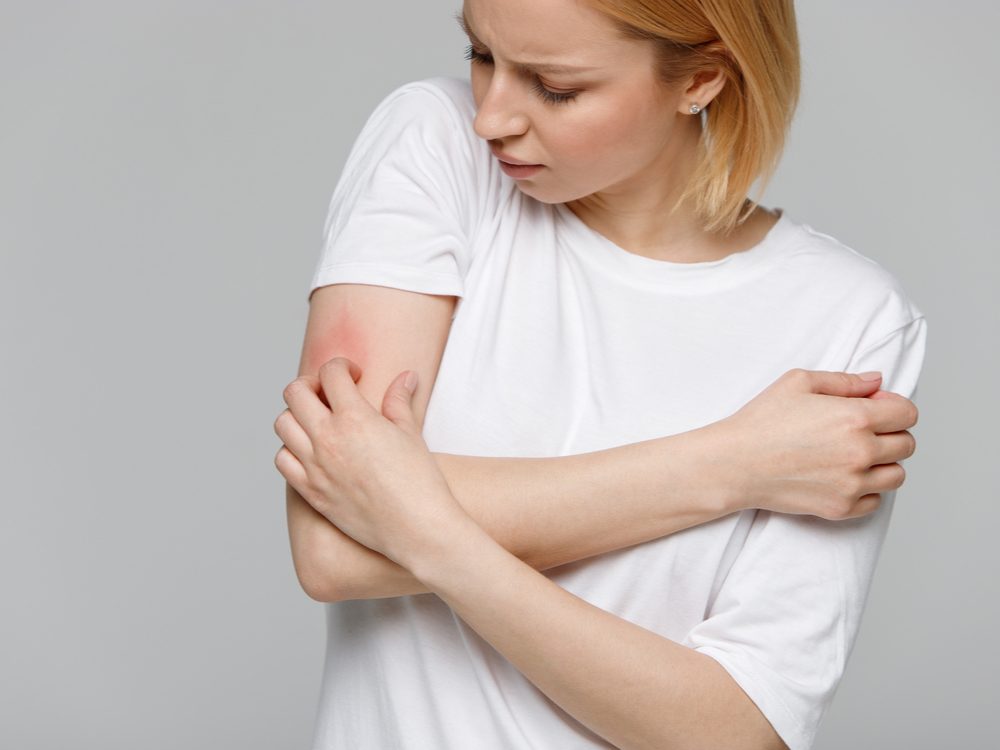
What’s Wrong with Me?
The patient: Eva (name changed), a 36-year-old city clerk
The symptoms: Intense itching and skin rash
The doctor: Dr. Laurence Toutous Trellu, dermatologist, Geneva University Hospitals, Switzerland
In the spring of 2015, Eva and her husband had no immediate plans to move from their cozy apartment in Geneva, Switzerland, where they’d lived for years. But when Eva started itching all over—even waking up at night to scratch—and her skin erupted in lesions, her family doctor guessed that her home was likely infested with bedbugs. Eva hadn’t spotted any signs of the pests, nor did her husband complain of bites. Nevertheless, she called exterminators.
When their services made no difference, Eva’s anxiety escalated. The unbearable itching was constant, and her sleep suffered. Pushed to a breaking point, she and her husband found a new place to live. But the itching didn’t stop.
Eva’s doctor ran a few simple blood tests, including one looking at kidney function and another at liver enzymes, and took a chest X-ray, but these were normal. Eva had a slightly high level of an antibody called IgE, which could indicate allergies. But antihistamines didn’t get rid of the itching or the rash, and topical steroid creams didn’t help, either. Unable to sleep or stop scratching, let alone focus on work, Eva reluctantly took a leave from her job.
Fourteen months after the itching started, small, hard lumps, or skin nodules, began appearing on Eva’s arms, legs, back and buttocks. This condition is called nodular prurigo, and it sometimes develops after long-term scratching. There are numerous underlying conditions that can be associated with it, including kidney disease and anemia, but anxiety and depression are also triggers. Since Eva appeared physically healthy, her doctor theorized that anxiety from the initial bedbug bites may have led to chronic, unstoppable itching.
Eva was referred to the dermatology department at Geneva University Hospitals, where a skin patch test was performed to double-check for allergies. “It’s non-invasive, and we try to eliminate simple environmental things first, as it’s very easy to do,” says Dr. Laurence Trellu, a senior physician in the department who oversees many of the complex cases. The test was negative. Nodular prurigo often responds to ultraviolet light therapy or antidepressants, but in Eva’s case, these weren’t effective.
Watch out for these strange symptoms that can signal a serious disease.

Searching Step by Step
The doctors didn’t give up on her. “In many medical cases that are this challenging, the risk is that the physician just forgets it, and the patient is desperate,” notes Trellu. “Many patients with a chronic skin disease end up going from one dermatologist to the next.”
She adds that especially when a patient is young and previously healthy, practitioners may assume the problem will eventually resolve itself, and they may even skip over aspects of a thorough workup. But a systematic, step-by-step approach is taken at her clinic, and Eva felt believed and supported—especially by the doctor she saw most often, Dr. Marc Pechère.
Eva still couldn’t sleep or go to work, however. She tried whole-body cryotherapy, enclosing herself in a sub-zero chamber in a bid to stop the itch. Cryotherapy is neither proven nor completely safe—it can aggravate a heart condition, for instance—and while it provided Eva with some temporary relief, it was no cure.
Six months later, Eva started feeling pain around the skin nodules. She also now had severe fatigue and nighttime chills, which can sometimes signal an internal disease. Eva’s family doctor prescribed a corticosteroid, a strong anti-inflammatory drug, as it can sometimes help with nodular prurigo after other treatments fail. But after two weeks on the drug, Eva was back in her doctor’s office, feeling worse.
Now, as the doctor examined her patient, she detected something that hadn’t been there before: a swollen lymph node on Eva’s chest, near her shoulder. Concerned, she ordered a new chest X-ray. It showed multiple enlarged lymph nodes. On a CT scan, the growths looked suspiciously like cancer.
Feeling itchy? Read up on these common skin conditions.

A Diagnosis at Last
And indeed, a biopsy of several of the nodes led to a clear diagnosis: Eva had nodular sclerosis Hodgkin lymphoma, a cancer of the immune system. This cancer is most common in those aged age 15 to 35, but fewer than three in 100,000 people develop it every year. It’s almost impossible to diagnose when the earliest symptoms not only match a wide variety of diseases and conditions, but are blamed solely on the patient’s state of mind.
“The psychological explanations do come when you find nothing,” says Trellu. But even someone with a mental health condition can have an underlying disease causing itching, she points out, which is why it’s important to keep investigating. “You wouldn’t want to miss lymphoma in a psychiatric patient.”
Fortunately, Eva’s cancer was still at an early stage. She started chemotherapy; her itching and pain improved dramatically after the first session. The skin lesions began healing.
Eva finished chemo treatments in October 2017 and currently sees her oncologist every six months. She has more energy, and she’s even back at work. “I still sometimes have the sensation of an ant crawling over my skin, and it makes me want to scratch,” she says, though she admits it’s probably the same feeling everyone has from time to time. But for her, it’s also a reminder of the long and difficult ordeal she went through. “I hope my story can educate both health professionals and patients,” Eva adds.
Next, learn about the diseases doctors are most likely to miss.